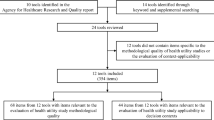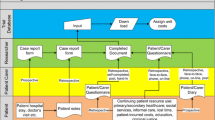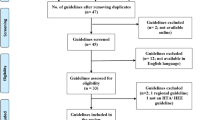Abstract
This paper proposes recommendations for a minimum level of searching for data for key parameters in decision-analytic models of cost effectiveness and describes sources of evidence relevant to each parameter type. Key parameters are defined as treatment effects, adverse effects, costs, resource use, health state utility values (HSUVs) and baseline risk of events. The recommended minimum requirement for treatment effects is comprehensive searching according to available methodological guidance. For other parameter types, the minimum is the searching of one bibliographic database plus, where appropriate, specialist sources and non-research-based and non-standard format sources. The recommendations draw on the search methods literature and on existing analyses of how evidence is used to support decision-analytic models. They take account of the range of research and non-research-based sources of evidence used in cost-effectiveness models and of the need for efficient searching. Consideration is given to what constitutes best evidence for the different parameter types in terms of design and scientific quality and to making transparent the judgments that underpin the selection of evidence from the options available. Methodological issues are discussed, including the differences between decision-analytic models of cost effectiveness and systematic reviews when searching and selecting evidence and comprehensive versus sufficient searching. Areas are highlighted where further methodological research is required.


Similar content being viewed by others
References
Paisley S. Classification of evidence in decision-analytic models of cost-effectiveness: a content analysis of published reports. Int J Technol Assess Health Care. 2010;26(04):458–62.
Golder S, Glanville J, Ginnelly L. Populating decision-analytic models: the feasibility and efficiency of database searching for individual parameters. Int J Technol Assess Health Care. 2005;21(03):305–11.
Kaltenthaler E, Tappenden P, Paisley S. NICE DSU Technical Support Document 13: identifying and reviewing evidence to inform the conceptualisation and population of cost-effectiveness models. Sheffield: NICE Decision Support Unit, University of Sheffield; 2011.
Coyle D, Lee KM, Cooper NJ. Use of evidence in decision models. In: Shemilt I, Mugford M, Vale L, Marsh K, Donaldson C, editors. Evidence-based decisions and economics: health care, social welfare, education and criminal justice. 2nd ed. London: Wiley: BMJ; 2010. p. 106–13.
Cooper N, Coyle D, Abrams K, Mugford M, Sutton A. Use of evidence in decision models: an appraisal of health technology assessments in the UK since 1997. J Health Serv Res Policy. 2005;10(4):245–50.
Philips Z, Ginnelly L, Sculpher M, Claxton K, Golder S, Riemsma R. Review of guidelines for good practice in decision-analytic modelling in health technology assessment. Health Technol Assess. 2004;8(36).
Higgins JPT, Green, S. Cochrane handbook for systematic reviews of interventions. Version 5.1.0 [Updated March 2011].Version 5.1.0. Available from: http://www.cochrane-handbook.org. Accessed 11 Nov 2015.
Centre for Reviews and Dissemination. Systematic reviews: CRD’s guidance for undertaking reviews in health care. 3rd ed. York: CRD, University of York; 2009.
Wong R, Paisley S, Carroll C. Assessing searches in NICE single technology appraisals: practice and checklist. Int J Technol Assess Health Care. 2013;29(03):315–22.
Zechmeister-Koss I, Schnell-Inderst P. Zauner G+. Appropriate evidence sources for populating decision analytic models within health technology assessment (HTA): a systematic review of HTA manuals and health economic guidelines. Med Decis Mak. 2014;34(3):288–99.
Booth A. How much searching is enough? Comprehensive versus optimal retrieval for technology assessments. Int J Technol Assess Health Care. 2010;26(04):431–5.
Royle P, Waugh N. Literature searching for clinical and cost-effectiveness studies used in health technology assessment reports carried out for the National Institute for Clinical Excellence appraisal system [Review]. Health Technol Assess. 2003;7:1–51.
US National Library of Medicine, National Institutes of Health. PubMed.gov. http://www.ncbi.nlm.nih.gov/pubmed. Accessed 11 Nov 2015.
ISSG. InterTASC Information Specialists’ Sub-Group Search Filter Resource. https://sites.google.com/a/york.ac.uk/issg-search-filters-resource/home. Accessed 11 Nov 2015.
National Institute for Health and Care Excellence. Guide to the methods of technology appraisal 2013. NICE; 2013.
Health Information Research Unit, McMaster University. Hedges Project. http://hiru.mcmaster.ca/hiru/HIRU_Hedges_home.aspx. Accessed 11 Nov 2015.
Cochrane. Cochrane Library. http://www.cochranelibrary.com/. Accessed 11 Nov 2015.
Centre for Reviews and Dissemination. CRD Database. http://www.crd.york.ac.uk/CRDWeb/. Accessed 11 Nov 2015.
Paisley S. Identifying evidence to inform decision-analytic models of cost-effectiveness: a qualitative study of information seeking processes and behaviour. Ph.D. Thesis. Sheffield: University of Sheffield; 2012.
Golder S, Loke YK. The contribution of different information sources for adverse effects data. Int J Technol Assess Health Care. 2012;28(2):133–7.
Golder S, McIntosh HM, Duffy S, Glanville J. Developing efficient search strategies to identify reports of adverse effects in medline and embase. Health Inf Libr J. 2006;23(1):3–12.
Golder S, Wright K, Rodgers M. Failure or success of search strategies to identify adverse effects of medical devices: a feasibility study using a systematic review. Syst Rev. 2014;3:113.
Golder S, Loke YK. Sensitivity and precision of adverse effects search filters in MEDLINE and EMBASE: a case study of fractures with thiazolidinediones. Health Inf Libr J. 2012;29(1):28–38.
US National Library of Medicine, National Institutes of Health. TOXLINE. http://toxnet.nlm.nih.gov/newtoxnet/toxline.htm. Accessed 11 Nov 2015.
Thomson Reuters. Derwent Drug File. http://www.ovid.com/site/catalog/databases/893.jsp. Accessed 11 Nov 2015.
Thomson Reuters. International Pharmaceutical Abstracts. https://health.ebsco.com/products/international-pharmaceutical-abstracts. Accessed 11 Nov 2015.
Golder S, Loke YK. Sources of information on adverse effects: a systematic review. Health Info Libr J. 2010;27(3):176–90.
US Food and Drug Administration. MedWatch: the FDA safety information and adverse event reporting program. http://www.fda.gov/Safety/MedWatch/. Accessed 11 Nov 2015.
US Food and Drug Administration. Postmarket drug safety information for patients and providers. http://www.fda.gov/Drugs/DrugSafety/PostmarketDrugSafetyInformationforPatientsandProviders/. Accessed 11 Nov 2015.
MHRA. Medicines and Healthcare products Regulatory Agency (MHRA). https://www.gov.uk/government/organisations/medicines-and-healthcare-products-regulatory-agency. Accessed 11 Nov 2015.
European Medicines Agency. EudraVigilance : pharmacovigilance in the European economic area. https://eudravigilance.ema.europa.eu/highres.htm. Accessed 11 Nov 2015.
VigiAccess™. http://who-umc.org/DynPage.aspx?id=132936&mn1=7347&mn2=7252&mn3=7254&mn4=7753. Accessed 11 Nov 2015.
Vashisth S, Singh G, Nanda A. A comparative study of regulatory trends of pharmaceuticals in Brazil, Russia, India and China (BRIC) countries. J Generic Med. 2012;9(3):128–43.
Glanville J, Paisley S. Searching for evidence for cost-effectiveness decisions. In: Shemilt I, Mugford M, Vale L, Marsh K, Donaldson C, editors. Evidence-based decisions and economics: health care, social welfare, education and criminal justice. 2nd ed. London: Wiley: BMJ; 2010. p. 79–92.
Centre for Reviews and Dissemination. CRD Database: search strategies. http://www.crd.york.ac.uk/crdweb/searchstrategies.asp. Accessed 11 Nov 2015.
Center for the Evaluation of Value and Risk in Health (CEVR), Tufts University. CEA Registry : Cost-Effectiveness Analysis Registry. https://research.tufts-nemc.org/cear4/SearchingtheCEARegistry/SearchtheCEARegistry.aspx. Accessed 11 Nov 2015.
Department of Health, England. NHS Reference Costs. https://www.gov.uk/government/collections/nhs-reference-costs. Accessed 11 Nov 2015.
British Medical Association and Royal Pharmaceutical Society. British National Formulary (BNF). https://www.medicinescomplete.com/about/publications.htm. Accessed 11 Nov 2015.
Curtis, Lesley. Unit Costs of Health and Social Care 2014. http://www.pssru.ac.uk/project-pages/unit-costs/2014/. Accessed 11 Nov 2015.
UTHealth, School of Public Health University of Texas. Search filters for various databases. http://libguides.sph.uth.tmc.edu/ovid_medline_filters. Accessed 11 Nov 2015.
Agency for Healthcare Research and Quality (AHRQ). National Guideline Clearinghouse. http://www.guideline.gov/. Accessed 11 Nov 2015.
Office for National Statistics (ONS). http://www.ons.gov.uk/ons/index.html. Accessed 11 Nov 2015.
Health and Social Care Information Centre (HSCIC). Healthcare Resource Groups (HRGs). http://www.hscic.gov.uk/hrg. Accessed 11 Nov 2015.
Health and Social Care Information Centre (HSCIC). Hospital Episodes Statistics (HES). http://www.hscic.gov.uk/hes. Accessed 11 Nov 2015.
Health and Social Care Information Centre (HSCIC). Data Access Request Service. http://www.hscic.gov.uk/dars. Accessed 11 Nov 2015.
Academy of Medical Royal Colleges. Royal Colleges. http://www.aomrc.org.uk/Royal-Colleges/. Accessed 11 Nov 2015.
King’s Fund. http://www.kingsfund.org.uk/. Accessed 11 Nov 2015.
Papaioannou D, Brazier J, Paisley S. NICE DSU Technical Support Document 9: the identification, review and synthesis of health state utility values from the literature. Sheffield: NICE Decision Support Unit, University of Sheffield; 2010.
Brazier J, Papaioannou D, Cantrell A, Paisley S. Identifying and reviewing health state utility values for populating decision models. In: Shemilt I, Mugford M, Vale L, Marsh K, Donaldson C, editors. Evidence-based decisions and economics: health care, social welfare, education and criminal justice. 2nd ed. London: Wiley: BMJ; 2010. p. 93–105.
ScHARRHUD (ScHARR Health Utilities Database). http://www.scharrhud.org. Accessed 11 Nov 2015.
Thomson Reuters. Incidence and Prevalence Database. http://thomsonreuters.com/en/products-services/pharma-life-sciences/pharma-business-development/incidence-and-prevalence-database.html. Accessed 11 Nov 2015.
Centers for Disease Control and Prevention. http://www.cdc.gov/. Accessed 11 Nov 2015.
World Health Organization. http://www.who.int/. Accessed 11 Nov 2015.
Kaltenthaler E, Essat M, Tappenden P, Paisley S. Identification and review of cost-effectiveness model parameters: a qualitative study. Int J Technol Assess Health Care. 2014;30(03):333–40.
Ara R, Tumur I, Pandor A, Duenas A, Williams R, Wilkinson A, Paisley S, Chilcott J. Ezetimibe for the treatment of hypercholesterolaemia: a systematic review and economic evaluation. Health Technol Assess. 2008;12(21).
Pandor A, Eggington S, Paisley S, Tappenden P, Sutcliffe P. The clinical and cost-effectiveness of oxaliplatin and capecitabine for the adjuvant treatment of colon cancer: systematic review and economic evaluation. Health Technol Assess. 2006;10(41):1–204.
Brunetti M, Ruiz F, Lord J, Pregno S, Oxman AD. Grading economic evidence. In: Shemilt I, Mugford M, Vale L, Marsh K, Donaldson C, editors. Evidence-based decisions and economics: health care, social welfare, education and criminal justice. 2nd ed. London: Wiley: BMJ; 2010. p. 114–33.
Author information
Authors and Affiliations
Corresponding author
Ethics declarations
No funding was received for the funding of this study or for the preparation of this manuscript. The author does not have any conflicts of interest to declare.
Rights and permissions
About this article
Cite this article
Paisley, S. Identification of Evidence for Key Parameters in Decision-Analytic Models of Cost Effectiveness: A Description of Sources and a Recommended Minimum Search Requirement. PharmacoEconomics 34, 597–608 (2016). https://doi.org/10.1007/s40273-015-0372-x
Published:
Issue Date:
DOI: https://doi.org/10.1007/s40273-015-0372-x




